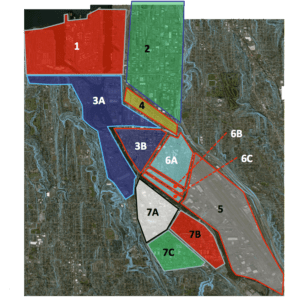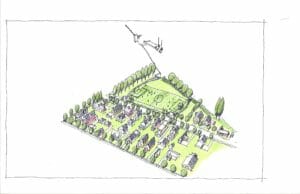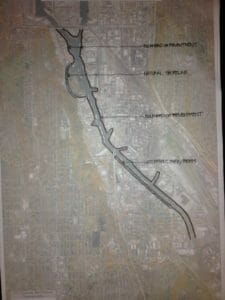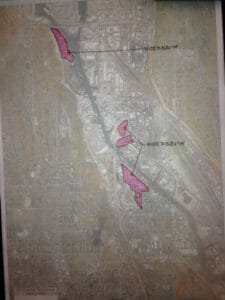Top Story
Date: June 21-26, 2015
Location: Seattle, Washington
Sponsor: City of Seattle
Subject Area: Lower Duwamish River Study Area/Duwamish Economic, Community, and Ecological Complex
Panel Chair: James DeFrancia
Download Full Report
Background and Panel Assignment
The Kresge Foundation awarded ULI an $800,000 grant to support its pursuit of urban design and practices that promote development that are more resilient and adaptable to the impact of climate change. As part of the Kresge grant, ULI is conducting advisory services panels to address resilience-related challenges and vulnerabilities to climate and sea-level changes. The hope is that the results of such panels can be applied to other communities with similar vulnerabilities.
Seattle is the largest city in the State of Washington with a population of approximately 662,400 (2015 estimate). Seattle lies on a narrow strip of land between the salt waters of Puget Sound and the fresh waters of Lake Washington. Beyond the waters lie two rugged mountain ranges, the Olympics to the west and the Cascades to the east.
 The frequency and magnitude of coastal flooding will increase over time due to sea level rise. Existing annual events are projected to become monthly events by 2035 and, eventually, will become daily events by 2060. The largest land areas at risk of increasing coastal flooding due to sea level rise are along the Duwamish River. The study area included the Georgetown and South Park neighborhoods. These areas include a significant manufacturing industrial area which provides high wage jobs as well as transportation infrastructure for major truck routes and intermodal facilities critical for transpacific shipping. Intermixed within the industrial uses are vibrant communities home to lower income residents and communities of color, many with limited English proficiency, living in single family and multifamily homes.
The frequency and magnitude of coastal flooding will increase over time due to sea level rise. Existing annual events are projected to become monthly events by 2035 and, eventually, will become daily events by 2060. The largest land areas at risk of increasing coastal flooding due to sea level rise are along the Duwamish River. The study area included the Georgetown and South Park neighborhoods. These areas include a significant manufacturing industrial area which provides high wage jobs as well as transportation infrastructure for major truck routes and intermodal facilities critical for transpacific shipping. Intermixed within the industrial uses are vibrant communities home to lower income residents and communities of color, many with limited English proficiency, living in single family and multifamily homes.
The panel was tasked with finding recommendations for enhancing the resilience of Georgetown and South Park against both sea level rise and increasing stormwater from a changing climate. In addition, the panel produced various strategies to promote the growth of the industrial area for the regional economy and highlight the short- and longer-term needs of the neighborhood residents.
Summary of Recommendations
In order to provide a holistic framework for resilience, and internal coherence between policy, operational and infrastructure recommendations, the ULI team developed the following “ideal conditions” to serve as aspirational targets for the future of the greater Duwamish area.
- High internal cohesion and external connectivity. This recommendation addresses the importance of having both physical connectivity (via roads, bridges and trails) and also social networks, developed through civic organizations and community organizing, in order to enhance political relationships with the broader region.
- The built and natural environment to improve the welfare, health, and economy. Future policies, design considerations and land use patterns should support mobility, improved air quality, absorbency, and biodiversity.

- A diversified portfolio of land uses, building types, infrastructure investments make the area “shock-resistant.” The greater diversity with any sector, the greater the resistance to threats such as increasing environmental disaster, housing costs, and shifts in the economy.
- Increased self-reliance and internal investment. Changes the Duwamish area has been waiting for can come from within and not just coordinated investment and activities by external partners.
- Low life-cycle cost and high co-benefit investments, with nature-based principles, where prudent. Investments should be made with a longer time horizon in mind, eyeing future maintenance costs and provide a fuller array of possible benefits. Nature-based systems should be employed in situations where there is a high degree of confidence as to their long-term effectiveness.
- Investments that build future-oriented multi-threat preparedness also improve day-to-day quality of life. Investments like increasing water access, food access, or increasing neighborhood parks support healthier living. They also support longer-term resilience strategies.
Some key recommendations included:
- Create an Urban Resilience District. Consider modifying some of the restrictions on non-industrial uses in SoDo and channel some of the developer investment toward retrofitting parts of Georgetown and South Park. This could be accomplished by creating an “urban resiliency fund” to help assist in the development of needed parks, support a land bank, roads, sewer, water treatment, utility and redundancy needs, particularly in the lower income South Park and Georgetown neighborhoods. Community Revitalization Financing, a city-based Local Revitalization Financing, or New Market Tax Credits could also be utilized for financing improvements.
- Impact Districts. ULI team identified 11 areas that have differing “impact
 characteristics.” Individual areas have varying responses and strategies to address short- and longer-term resilience needs including both grey and green infrastructure. These range from locks and hardened bulkheads, to riverside park/berms, bio- swales, and rain barrels. The Panel Presentation addresses these approaches in more detail.
characteristics.” Individual areas have varying responses and strategies to address short- and longer-term resilience needs including both grey and green infrastructure. These range from locks and hardened bulkheads, to riverside park/berms, bio- swales, and rain barrels. The Panel Presentation addresses these approaches in more detail. - Improve stormwater drainage. Divert some of the existing flow from Beacon Hill around the Georgetown neighborhood and raise some of the critical intersections to ensure traffic mobility during extreme storm events.
- A Coordinating Hub focused on Georgetown and South Park. This targeted effort should be overseen by a lead agency or organization with the capacity to facilitate a holistic, collaborative effort. This can also help leverage funding from federal, state, local, and philanthropies as well as allow participatory budgeting. A gap/needs analysis could be conducted as part of this coordination.
 Hold an annual State of the Duwamish Summit. Planning an annual community-wide convening at a time and place that is welcoming and sensitive to language, work schedule, accessibility, and childcare needs of the area at large should be considered. This State of the Duwamish Summit would share critical information about economic trends, development prospects, environmental remediation, and opportunities for civic engagement.
Hold an annual State of the Duwamish Summit. Planning an annual community-wide convening at a time and place that is welcoming and sensitive to language, work schedule, accessibility, and childcare needs of the area at large should be considered. This State of the Duwamish Summit would share critical information about economic trends, development prospects, environmental remediation, and opportunities for civic engagement.- Review and update of zoning codes. A review, modernization, and rationalization of zoning codes would lead in time to an increased mix of housing, industrial and business types, allowing the private market to respond to opportunities within the area. Some controls (e.g. “Planned Manufacturing Districts”) may be necessary to maintain land values to support some current or desired future industrial and manufacturing uses.
- Increase transportation options. These could include additional pedestrian, bike, and vehicular bridges, staircases up the bluffs, enhanced bike paths and sidewalks, water taxis, and greater transit stops/frequency to increase connectivity and increase resilience.